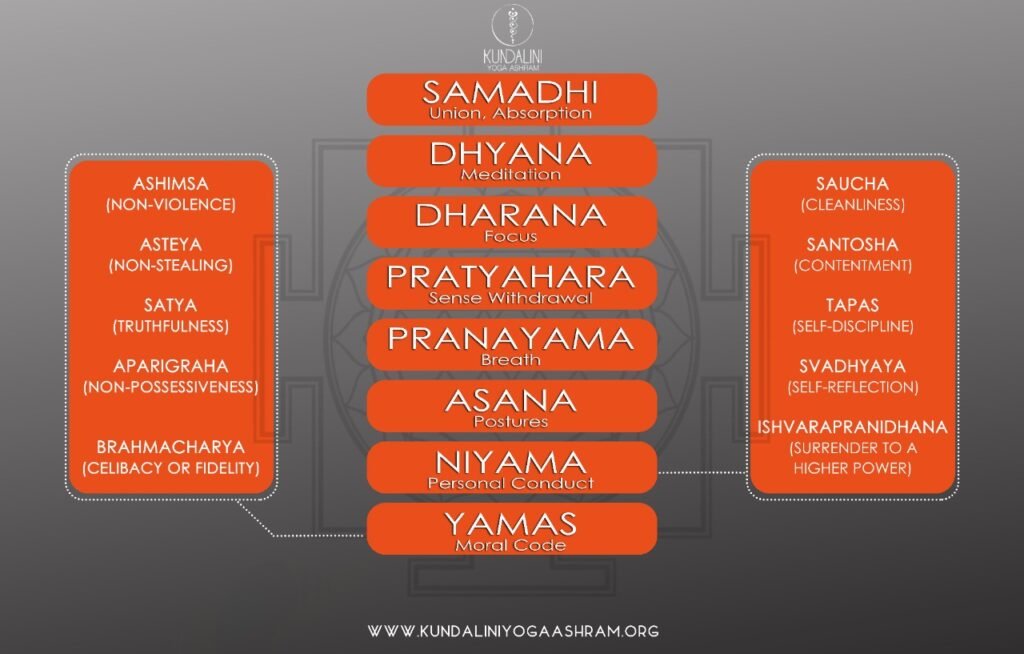You could be a yogi or yogini, looking for the steps to reach Samadhi. Additionally, you could also be someone, who is looking for bliss. You can attain the ultimate bliss in your life, through or by reaching the state of consciousness. It is something, that Hindus, Buddhists, and Jains will relate to. There is something common in Buddhism and Patanjali’s Yoga Sutras. And, that is the eight-fold path. In the final stages of both spiritual paths, you will find eternal bliss or enlightenment. The state of Samadhi is the ultimate destination. But before, we move ahead and define Samadhi, it is important to understand what the eight-fold path is, in complete detail.
The Eight Limbs of Yoga
Although you will find the idea of Samadhi, in many spiritual texts, it assumes a lot of significance in Ashtanga Yoga. It is the eight limbs of yoga, as outlined in Patanjali’s Yoga Sutras. The Indian sage Patanjali had written the texts in 400 C.E. The Eight limbs are nothing, but the steps that you need to cross, to attain enlightenment. When you reach the state of ultimate bliss or universal consciousness, you are said to reach Samadhi.

The eight limbs of Ashtanga Yoga are the path, that every sage who has ever attained Samadhi, needs to tread upon. The eight limbs are:
- Yamas: It is the external discipline which is more like universal values, which you need to follow.
- Niyama: It is the internal discipline which resembles your personal observation powers.
- Asana: The poses are the physical practises, that we mostly see people associating yoga with.
- Pranayama: It involves breath control, and it is said to have a direct connection to longevity.
- Pratyahara: It deals with the withdrawal of the senses or you could say, ‘Tyaag’.
- Dharana: You can increase your concentration, through this practice. So, that takes you one step further towards your goals.
- Dhyana: It is meditation that we are talking about here. Once you have total control over your mind, your mind becomes receptive to the ultimate consciousness.
- Samadhi: It is the final stage of bliss, or union of the soul with the cosmic realm.
Dharana, dhyana and samadhi are focussed on the internal controls. Once, you have completed and won over the external ones, that is the first five, you get to control the last three. Now, you can understand what Samadhi, in a better manner.
Samadhi – The Ultimate Bliss
It is that ultimate stage of your sadhana, when thoughts cannot weigh you down. The wheel of thoughts basically stops rotating. This is the ultimate goal of the path of yoga. Moreover, you are able to erase the difference between the subject and the object. It is also referred to as the stage of non-duality, when the self and the external world are same. So, you thought that attaining Samadhi is easy? Not really. If that would have been the case, every body would be moving around, all enlightened. Moreover, the meaning of Samadhi is different for different people. You need a lot of dedication to attain Samadhi. Many believe that you can only attain it, by the mental discipline that yoga brings around.
In reality, each person on the earth has the potential to reach Samadhi. You can also use the physical body, to transform your thoughts. When you are disease-free, the thoughts that revolve around the brain are also pure. So, you can focus more. The mantras are particularly useful, in this respect.
You need to move through certain stages of enlightenment to reach the final one.
Stage of Samadhi
The first stage of Samadhi is Sabija. It means seeds. You have to recognize that your concentration is actually the seeds. The seeds link understanding and the ego. There are a lot of occurrence and miseries that directly impact the ego. Unless and until, you are able to forget or disconnect with such feelings, you cannot move towards Samadhi.
Nirbija is the next step in the process. Once you stop getting affected by external stimuli, you can start discarding the object-subject difference in your life. It is that final stage of oneliness. Many people might confuse it with loneliness. However, it is different from oneliness.
To be exact, ‘Chitta vritti nirodha’ signals that you have attained Samadhi. However, it is easier said than done. All those who meditate on a regular basis, know that it is not easy to attain the final bliss.
When you sit down for meditation, and there is no sound around you, you are quite nearby. Moreover, no external stimuli can awaken you, except you, yourself. You will also feel connected to the natural surroundings around you. Then, again, you will be able to control your senses. At this time, you can derive that you have ultimately reached Samadhi.
Final Words
In Samadhi, you can neither see nor hear, any external object. You are not mentally or physically conscious. There is just one kind of consciousness, and that is spiritual consciousness. This is a kind of sleep, where you do not remember anything. The outside world also does not matter much. You could enter the state of Samadhi for ten minutes, fifteen minutes, or an hour. However, when you wake up from this sleep, you will feel better than what you would feel after an ordinary sleep. Now, you should not compare it with the state of inertia. It is not a stone-like formation. However, you will feel a different kind of aura around you.
The outside world will not seem to bother you. You may be baffled to know, that Hatha Yogis who practice Samadhi remain buried underneath the earth for years. However, they are not dead yet. They are in the ultimate state of bliss. They often block their nostrils, through Khechadi Mudra, so that external impurities cannot enter their bodies. This is a long process. So, working towards it is the only task you can undertake. When you achieve it, there is a lot of excitement in that final stage, but you will feel it internally, not externally.


